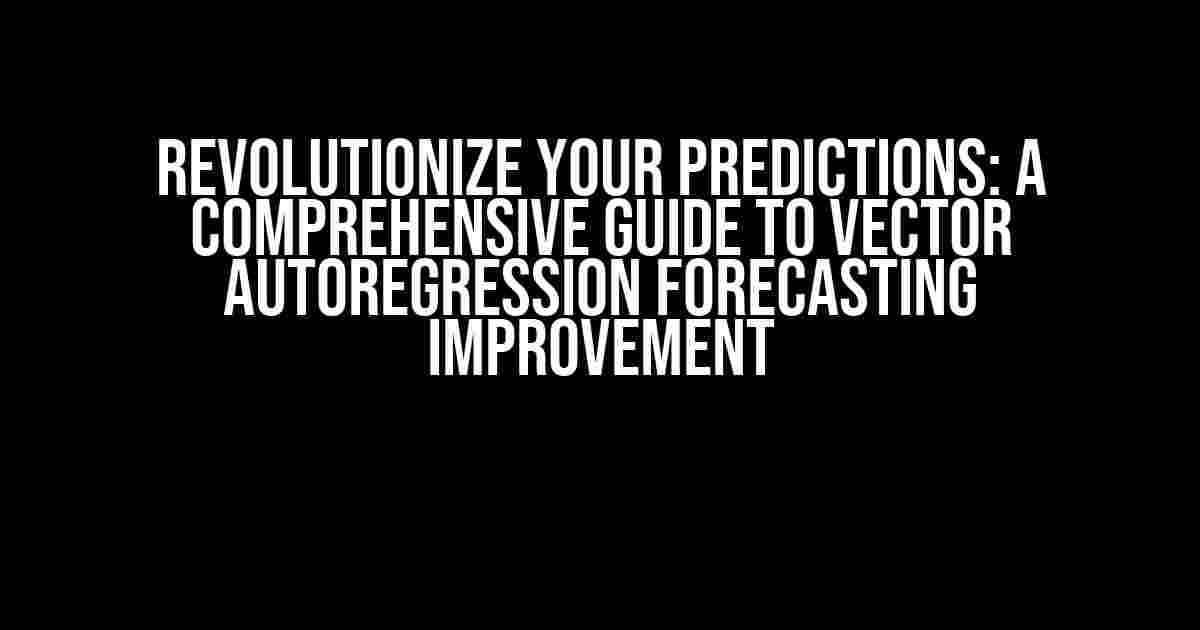Are you tired of mediocre forecasting results? Do you want to take your predictions to the next level? Look no further! In this article, we’ll dive into the world of vector autoregression (VAR) forecasting and provide you with actionable tips and techniques to improve your forecasting game.
What is Vector Autoregression (VAR) Forecasting?
Before we dive into the improvement strategies, let’s quickly recap what VAR forecasting is. Vector autoregression is a statistical model that captures the relationships between multiple time series variables. It’s a powerful tool used to forecast future values of multiple variables based on their past behavior.
In mathematical terms, a VAR model can be represented as: Y(t) = c + A1*Y(t-1) + A2*Y(t-2) + … + Ap*Y(t-p) + e(t) Where: Y(t) is a vector of k time series variables at time t c is a constant term A1, A2, …, Ap are matrices of coefficients p is the lag order e(t) is a vector of error terms
Challenges in VAR Forecasting
While VAR models are powerful, they’re not without their challenges. Some common issues include:
- Model overfitting: When the model is too complex and fits the noise in the data rather than the underlying patterns.
- Multicollinearity: When two or more variables are highly correlated, leading to unstable estimates and poor forecasting performance.
- Model selection: Choosing the optimal lag order and variables can be a daunting task.
- Data quality: Poor data quality can lead to inaccurate forecasts.
Improvement Strategies for VAR Forecasting
Now that we’ve covered the basics, let’s dive into the exciting part – improving your VAR forecasting skills!
1. Data Preprocessing
A critical step in any forecasting exercise is data preprocessing. Make sure to:
- Handle missing values: Use techniques like mean or median imputation to fill in gaps.
- Normalize and scale: Standardize your data to have zero mean and unit variance.
- Remove outliers: Identify and remove data points that are significantly different from the rest.
- Transform variables: Apply transformations like log or square root to stabilize variance and improve model performance.
2. Feature Selection and Engineering
Selecting the right features and creating new ones can significantly improve your forecasting performance. Try:
- Correlation analysis: Identify highly correlated variables and remove one of them to reduce multicollinearity.
- Principal component analysis (PCA): Reduce dimensionality and extract meaningful features.
- Feature extraction: Use techniques like moving averages or exponential smoothing to create new features.
3. Model Selection and Hyperparameter Tuning
Choosing the optimal model and hyperparameters is crucial for good forecasting performance. Explore:
- Model selection criteria: Use metrics like Akaike information criterion (AIC) or Bayesian information criterion (BIC) to select the best model.
- Grid search: Perform a systematic search over a range of hyperparameters to find the optimal combination.
- Cross-validation: Evaluate your model on unseen data to ensure it generalizes well.
4. Ensemble Methods
Combining the predictions of multiple models can lead to improved forecasting performance. Try:
- Bagging: Combine the predictions of multiple models trained on different subsets of the data.
- Stacking: Use a meta-model to combine the predictions of multiple base models.
- Boosting: Combine multiple weak models to create a strong predictor.
5. Model Evaluation and Refining
Continuously evaluate and refine your model to ensure it remains accurate over time. Use:
- Mean absolute error (MAE) and mean squared error (MSE): Track these metrics to evaluate model performance.
- Backtesting: Evaluate your model on historical data to identify areas for improvement.
- Walk-forward optimization: Refine your model by re-estimating parameters using rolling windows of data.
Real-World Applications of VAR Forecasting
Vector autoregression forecasting has numerous applications in:
| Industry | Application |
|---|---|
| Finance | Predicting stock prices, exchange rates, and portfolio returns |
| Economics | Forecasting GDP, inflation, and unemployment rates |
| Energy | Predicting energy demand, prices, and renewable energy output |
| Marketing | Forecasting sales, customer churn, and market trends |
Conclusion
Vector autoregression forecasting is a powerful tool for predicting multiple time series variables. By following the improvement strategies outlined in this article, you can take your forecasting skills to the next level. Remember to:
- Preprocess your data carefully
- Select and engineer features thoughtfully
- Choose the optimal model and hyperparameters
- Combine models using ensemble methods
- Evaluate and refine your model continuously
With these tips and techniques, you’ll be well on your way to revolutionizing your predictions and achieving forecasting improvement.
Further Reading
For a deeper dive into VAR forecasting, we recommend:
- “Vector Autoregression” by James D. Hamilton (1994)
- “Forecasting with Vector Autoregression Models” by Helmut Lütkepohl (2005)
- “Applied Time Series Analysis and Forecasting” by Steven B. Achelis (2019)
Stay ahead of the curve and improve your forecasting skills today!
Frequently Asked Question
Whether you’re a seasoned econometrician or a curious data enthusiast, these FAQs will help you navigate the world of vector autoregression forecasting improvement!
What is vector autoregression (VAR) and how does it improve forecasting?
Vector autoregression (VAR) is a statistical model that captures the relationships between multiple time series variables. By considering the interdependencies between these variables, VAR models can provide more accurate and robust forecasts. In essence, VAR improves forecasting by accounting for the intricate dynamics between variables, leading to more informed decision-making in fields like finance, economics, and business.
How does VAR modeling address the issue of multicollinearity?
One of the major concerns in VAR modeling is multicollinearity, where two or more variables are highly correlated. To address this issue, researchers often employ techniques like principal component analysis (PCA) or partial least squares (PLS) to reduce the dimensionality of the data and avoid multicollinearity. Additionally, using Bayesian VAR models or imposing constraints on the model parameters can also help mitigate multicollinearity.
What is the role of exogenous variables in VAR modeling?
Exogenous variables, also known as external factors, can be incorporated into VAR models to capture the influence of external events or shocks on the system. These variables can be useful in explaining sudden changes or structural breaks in the data. By including exogenous variables, researchers can better understand how the system responds to external stimuli, leading to more accurate forecasting and policy analysis.
How can I evaluate the performance of a VAR model?
Evaluating the performance of a VAR model is crucial to ensure its reliability and accuracy. Some common metrics used to assess VAR model performance include mean absolute error (MAE), mean squared error (MSE), and Bayesian information criterion (BIC). Additionally, researchers often employ out-of-sample forecasting exercises, like rolling window forecasts, to evaluate the model’s ability to predict future outcomes.
What are some common applications of VAR models in forecasting?
VAR models have a wide range of applications in forecasting, including macroeconomic forecasting, financial forecasting, and energy demand forecasting. They are particularly useful in predicting variables that exhibit complex interdependencies, such as GDP growth rates, inflation rates, stock prices, and exchange rates. By capturing these relationships, VAR models can provide policymakers and businesses with valuable insights for informed decision-making.




